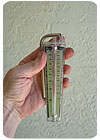
One of the most-needed and least-owned HVACR test instruments is one that reads air handler static pressures. The fact is, most residential and many commercial HVACR systems that rely on interior air motion are either undersized or have clogged components, and most technicians carry nothing at all to diagnose the problem!
It’s as simple as this: If the pressure across an air handler or furnace (as read from the return to the discharge) is higher than specified, it isn’t circulating enough air, so it’s losing efficiency and the evaporator coil is in danger of freezing, or the furnace is in danger of overheating. Also, if the air pressure across an evaporator coil exceeds its specification limits, it is clogged and needs to be cleaned. However, if that coil is an internal part of the air handler, the air handler output pressures will be low. This isn’t brain surgery, just common sense!
Did I say that most residential systems don’t move enough air? Yes, in my experience this is true. The maximum design static pressure across most residential air handlers is .5-inch of water column (wg). Yet I know many contractors who design all their discharge ductwork (forgetting what’s happening at the return) at 1-inch, which puts the resulting air flow well under proper design minimums!
Then there are other factors that enter the picture, such as closed discharge grilles, the common use of high-static-pressure air filters (such as electrostatic filters), undersized returns, rooms with closed doors that have no returns, and most of all, dirty evaporator (indoor) coils. However, air handlers should also be checked to ensure that their blowers are clean, working properly, and set at the correct speed.
Do you know how most HVACR service technicians diagnose and find such problems? They usually start out by taking refrigerant pressure readings. If they find low refrigerant pressures, they commonly add refrigerant to bring the pressures up, grossly overcharging the system. When this doesn’t work, they check the air filters, then they start tearing things open to visually find the problem - which takes a long time and usually does some damage along the way.
However, there are simple, inexpensive service tools to quickly diagnose these problems: static pressure gauges. I really like Dwyer’s Model 460 Air Meter (it’s the one I’ve used for years). It’s small, easy to use, and quite inexpensive. So I suggest that you look into stocking them, but then you may have to provide training classes to show technicians how to use them and how to diagnose problems from the readings.
The problem with some static-pressure gauges is that they can be quite expensive, they are often unwieldy, and some employ a special liquid that leaks out. However, the Dwyer air gauge uses no oil, it doesn’t have to be dead level to work well, and it can also be employed to check air velocities.
To use a static-pressure gauge, you simply drill a 1/4-inch hole in the entering and leaving ducts. Then connect the included rubber hose from the hole in the duct discharge to the input side of the gauge - on the Model 460 you hold your thumb over the output side of the gauge to put it into the proper range - and take a reading. Then connect the hose from the hole in the return duct to the gauge output side to get a negative-pressure reading. Thereafter, you add the static pressure from the negative to the positive to obtain the total static pressure reading (-.1 inch wg to +.4 inch wg = .5 inch wg). And finally, using metallic tape, seal the holes that you drilled.





